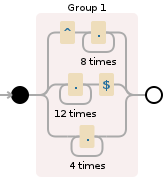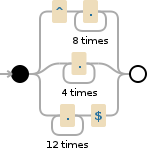How regular expression OR operator is evaluated
In T-SQL I have generated UNIQUEIDENTIFIER using NEWID() function. For example:
723952A7-96C6-421F-961F-80E66A4F29D2
Then,
-
If you are interested in what happens when you use | alternation operator, the answer is easy: the regex engine processes the expression and the input string from left to right.
Taking the pattern you have as an example,
^.{8}|.{12}$|.{4}starts inspecting the input string from the left, and checks for^.{8}- first 8 characters. Finds them and it is a match. Then, goes on and finds the last 12 characters with.{12}$, and again there is a match. Then, any 4-character strings are matched.
Debuggex Demo
Next, you have
^.{8}|.{4}|.{12}$. The expression is again parsed from left to right, first 8 characters are matched first, but next, only 4-character sequences will be matched,.{12}won't ever fire because there will be.{4}matches!
Debuggex Demo
讨论(0) -
Your Regex
^.{8}|.{12}$|.{4}evaluates to:Starting with any character except \n { Exactly 8 times }
OR any character except \n { Exactly 12 times }
OR any character except \n { Exactly 4 times } globally
This means that anything after 4 characters in a row will be matched because somewhere in a string of >4 characters there are 4 characters in a row.
1 [false]
12 [false]
123 [false]
1234 [true]
12345 [true]
123456 [true]
1234567 [true]
12345678 [true]
123456789 [true]
1234567890 [true]
12345678901 [true]
123456789012 [true]
You might be looking for:
^.{8}$|^.{12}$|^.{4}$Which gives you:
1 [false]
12 [false]
123 [false]
1234 [true]
12345 [false]
123456 [false]
1234567 [false]
12345678 [true]
123456789 [false]
1234567890 [false]
12345678901 [false]
123456789012 [true]
讨论(0)
- 热议问题

 加载中...
加载中...